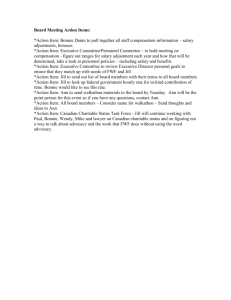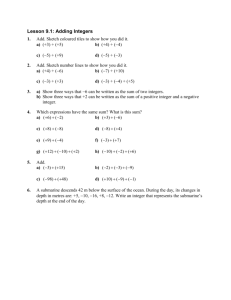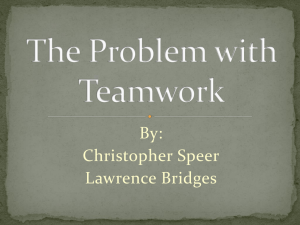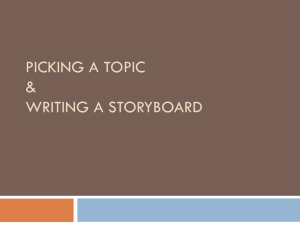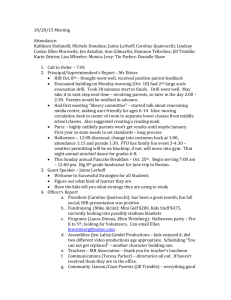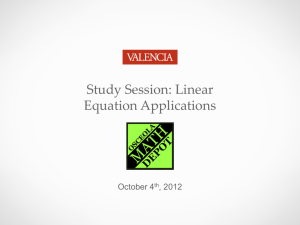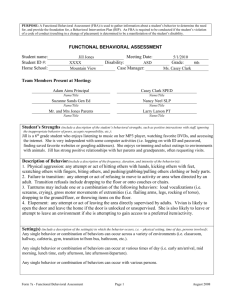Notes 2
advertisement
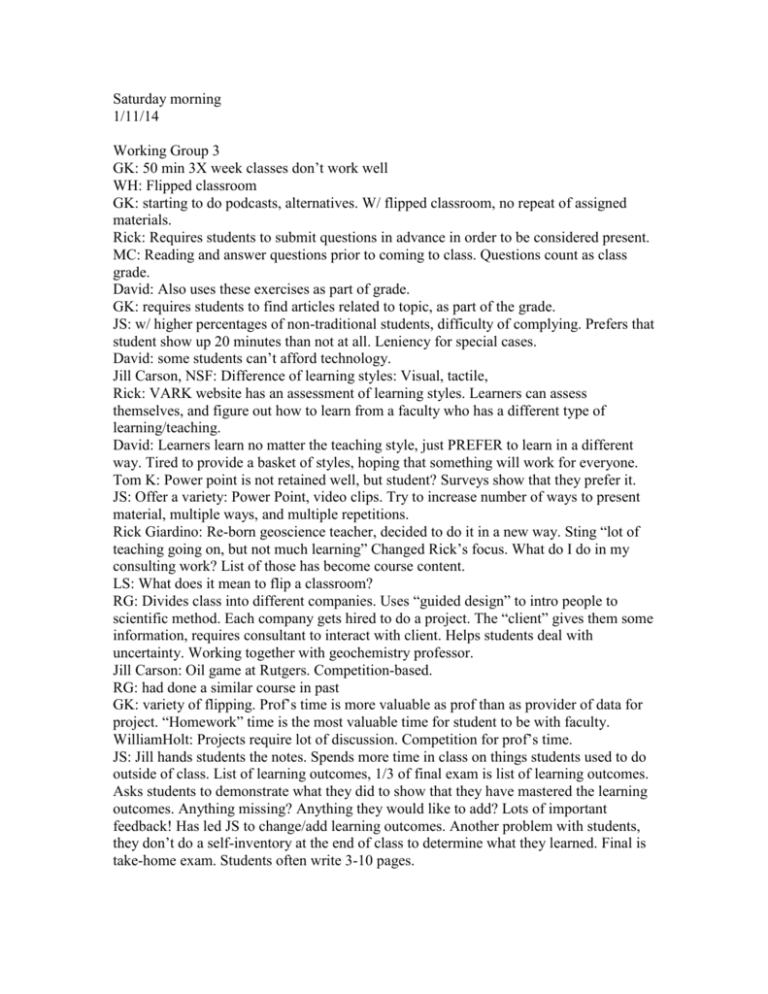
Saturday morning 1/11/14 Working Group 3 GK: 50 min 3X week classes don’t work well WH: Flipped classroom GK: starting to do podcasts, alternatives. W/ flipped classroom, no repeat of assigned materials. Rick: Requires students to submit questions in advance in order to be considered present. MC: Reading and answer questions prior to coming to class. Questions count as class grade. David: Also uses these exercises as part of grade. GK: requires students to find articles related to topic, as part of the grade. JS: w/ higher percentages of non-traditional students, difficulty of complying. Prefers that student show up 20 minutes than not at all. Leniency for special cases. David: some students can’t afford technology. Jill Carson, NSF: Difference of learning styles: Visual, tactile, Rick: VARK website has an assessment of learning styles. Learners can assess themselves, and figure out how to learn from a faculty who has a different type of learning/teaching. David: Learners learn no matter the teaching style, just PREFER to learn in a different way. Tired to provide a basket of styles, hoping that something will work for everyone. Tom K: Power point is not retained well, but student? Surveys show that they prefer it. JS: Offer a variety: Power Point, video clips. Try to increase number of ways to present material, multiple ways, and multiple repetitions. Rick Giardino: Re-born geoscience teacher, decided to do it in a new way. Sting “lot of teaching going on, but not much learning” Changed Rick’s focus. What do I do in my consulting work? List of those has become course content. LS: What does it mean to flip a classroom? RG: Divides class into different companies. Uses “guided design” to intro people to scientific method. Each company gets hired to do a project. The “client” gives them some information, requires consultant to interact with client. Helps students deal with uncertainty. Working together with geochemistry professor. Jill Carson: Oil game at Rutgers. Competition-based. RG: had done a similar course in past GK: variety of flipping. Prof’s time is more valuable as prof than as provider of data for project. “Homework” time is the most valuable time for student to be with faculty. WilliamHolt: Projects require lot of discussion. Competition for prof’s time. JS: Jill hands students the notes. Spends more time in class on things students used to do outside of class. List of learning outcomes, 1/3 of final exam is list of learning outcomes. Asks students to demonstrate what they did to show that they have mastered the learning outcomes. Anything missing? Anything they would like to add? Lots of important feedback! Has led JS to change/add learning outcomes. Another problem with students, they don’t do a self-inventory at the end of class to determine what they learned. Final is take-home exam. Students often write 3-10 pages. BH: Flipping may work with in-major classes, but with 101 classes, too many people, too much time. JS: reduce the scope. RG: Has anyone done a flipped class in a large classroom? BH: no David: has observed adjunct prof do this, lots of time. Needs lots of resources. Chairs not movable Matthew: Classes where students vote on things, slide with timer. Meena: How many faculty have “full-time” students? She does not. What to expect of non-traditional students? RG: Limit what you give students; allow them more time. David: 16 chapters in book, 16 weeks. LS: What can you swap out? BH: Has pared down intro geo over the years. JS: No longer uses textbooks. Springer, Coastlines of the World using Google Earth. Uses trade books. Uses the book on the tests. BH: In Geo 101, more than ½ students don’t buy books. Those who buy don’t open the book. Jill: Competence? David: Does not require textbooks. TomK: Disconnect between what we do & what we want to do. Textbooks still very traditional. Tom thinks most people teaching are still teaching in traditional way. Wants to teach differently, but doesn’t have time to develop. Would like template. JS: Some disciplines are doing better than others. New Geomorphology short book supplemented by online (title? Author?). TK: Teaching new class, how would you do it? David: Oceanography: Issue-oriented, Looking for data sets students can use. GK: Lamont Doherty has resources in this area. David: Wants data sets so students can work in groups. There’s no lab GK: Developed tectonics course about 10 years ago. Looked at syllabi of other prof. One great idea was UMass list of questions used at beginning and end of class. Has small classes, but thinks about large classes. Can we provide the type of course we want to a large group of people? Does the knowledge we want people to have require a 4-hr chunk in the expensive way we have provided it? Maybe can do 4-wk chunk? BH: Block model at Montana. GK: that’s just breaking up the same thing into smaller components, not really changing the paradigm. David: N.Arizona model: semester is no longer the smallest length of time in which we can deliver info. Has divided up to use resources better. Semester vs 10 week session. Can chunk things up into 2-3 or 4 wk session, have a 1 credit chunk. JS: J-term. Variable time chunks are more common than we perhaps realize. RG: value of 1-credit class. GK: Radical change is easier in small chunks. Jill: Backward design – what is the goal? Registrar constraints. GK: Goal is scientific literacy. Entire campus of literate people is perhaps not a realistic goal. Most people don’t even appreciate science, except for new vaccine. WH: Field course totally upsets idea of 3-hr/wk course. This year they studied floods because they were in the backyard. Recast the questions around what’s in the back yard re-focuses on what’s around us. Field course is expensive but beneficial. JS: Cathy Manduca’s presentation shows cup not full. May want to lower the bar. Teach a half-credit course to get started. What should the driver be? students’ needs or active pedagogy? Let’s get started. Jill: Student need vs artificial constraints of university due to finances. LS: Competence vs RG: Top 10 list of things he wants students to remember. Don’t build on the flood plain. This sometimes leads a student to change his major. Jill: Decouple learning goals, and develop structures to support GK: Don’t have “physical geo” course any more. Offer non-technical courses to interest students in the science. Courses: Life through time, Oceanography. David: Where’s the rock ID? GK: Not in intro, non-technical course. Teaching is on a Need-to-know basis. Matthew: How do get faculty to develop new pedagogy? Resources for faculty? Modules? David: Geo classes are already active learning, more so than other sciences: field trips. We need to focus on educating people outside geology because they will be voters. JS: What’s the action plan for putting these ideas into motion? Cathy’s survey. Show up to next faculty mtg and ask what active learning techniques they are using. Perhaps faculty are using them although not really aware. People perceive the bar to be high, so no one tries. They perceive themselves to be at zero, but they’re not. Then, how to build on what’s there already. WK: Discussion is intimidating because it seems like huge jump. Two-page to publicize baby steps to help people move forward. JS: Fac are intimidated by progress of others. BH: Vehicles are present to help introduce these concepts: post-tenure reviews, etc. Outsider review 4 years ago. Assessment matrix, talk to undergrads, what will the paragraph on your faculty evaluation look like? Review of courses offered. Assessing the department, but not very systematically. The way we give each other feedback and assess teaching is woefully inadequate. MatthewClapham: Best practices document should be incremental. David: Dissatisfaction of too many choices. JS: Have to chunk things for colleagues just as we chunk things for students. Jill: Most people not starting at zero. Env Science is intrinsically inquiry based. People need to be told they are already on the path. TK: Outcome of this meeting could be call to redesign the SERC website. GK: IRIS website. InClass. Idea is to apply quality criteria and to represent resources in relation to others? Initial question to apply structure: how much time do you want to spend on this topic? With this, the material becomes a resource. CW: There is a shortage of information at upper level geophysics. Jill: Intellectual property. Faculty are at risk of oversharing, to the benefit of the community, but question of professor adding value. JS: Anything developed as consequence of federal funding should be available for free, Jill: But you can still make a profit off it. JS: Some part of resources can be available. Depends on how community sees it, tenure consideration. University currency is still peer reviewed journal articles. MC: Creative commons. categories. Lawyer vs real person language. Jill: NSF funds institutions, not people. NCAR library controversy. Collapse of faculty. MC: Value is collaboration between student & faculty. GK: Faculty role is to be guide, mentor. GK believes that role is important. Jill: Do students think it’s valuable? GK: What’s most important in your education? Book or person? JS: Novice to expert continuum. Students cannot filter, process, and sort the information that's freely available. Does not think faculty will be replaced by internet/etc. There’s too much to choose from. RG: Students in college are lazy, need structure to be imposed on them. Steve Jobs and Bill Gates didn’t go to college. GK: Content is not the focus. David: Why is faculty necessary? Practice that needs to be applied in different areas, different applications of the models. LS: lots of students in 101, flip classroom, how does faculty provide value? GK: Part of faculty role is to generate excitement and be a role model. Students have been locked in school for 12 years but don’t yet know why learning is something they want to do on their own. JS: Return to final exam question, the feedback she gets from students. Students remember stories faculty has told. Faculty’s passion for subject energizes students. Lunch with students, question. What do students like about the program? Faculty likes what they teach and they like students. BH: game Jill: Most programs are at capacity. How can we use technology without losing the value of faculty? David: Efficiency vs effectiveness. Jill: How do we grow? How do we move into community colleges? BH: Identity of discipline; geo has always been interdisciplinary. Jill: How do you deal with overpopulation of programs? Business model. LS: Business model is changing. Jill: Other piece of pedagogy is internships, independent research, LS: Local element of partnerships were topic on Friday. Jill: Are internships integrated into programs? David: Not enough internships to go around. RG: Virtual internships, hire students during semester. Companies (Alaska) work with students daily. RS: Growth of professional science masters is leading to more industry-academic partnerships. LS: Partnerships between small schools to Cal Tech. GK: Trying to establish, wanted to make internship a requirement, but some students are not suitable. David: Environmental studies program has required internship with non-profit or local government. Write up on what student will do, get out of it. Student generated. Some paid, some not paid. ExxonMobil LS: Exxon Mobil internships are small finite resource. RG: In-course internships lead to summer internships. Industry high grades the interns. TK: In Billings, industry interferes with department. Wants to control department in terms of what they want students to know. But companies don’t hire 3-month internships, maybe would be interested in shorter term internship. Lots of industries are contractors. WH: Perhaps these industries are not the place to be looking for internships. Perhaps look at smaller companies, cement companies. JS: Companies may not be sure what they’ll get. Suggest a year-end symposium and ask industry rep to present. Have students present posters on what they know, make verbal presentation. Will begin Jill: If ask for money, company will give advice. Ask for advice, will eventually give money. TL: Industry recommended that students go to grad school – which is not an option for his students, most of whom don’t plan/can’t afford to go to grad school. JS: Try other ways to develop rapport. GK: Tells students they can get a job with a bachelors degree, need a masters for a career. LS: The masters is the coin of the realm, it’s the skills that come with the degree RG: and that’s changing because undergrads are developing those skills. GK: Even in boom time, need masters for career. Masters will pay for itself. Need a year between undergrad and grad to learn about where to go next. JS: Impediment in geosciences has been: in order to make this a viable profession, you need a masters degree. When reaching out to non-trad audiences, there are lots of other choices where a 4-year degree gets you an intro to a career ladder with good income. The bachelors will get you an entry level job now, but this fact will change, perhaps during students years in school. Jill: Most students go into geosciences as a grad student. With minorities those trends are the same, start late. JG: What’s the reason for our late growth? Jill: No AP course, poor visibility. Also cultural factors among 1st generation college attendees (law, medicine). Field work not held in esteem. WH: teacher training has led to more geo students Jill: Geology of Mexico class, Bakerfield. Lunch
